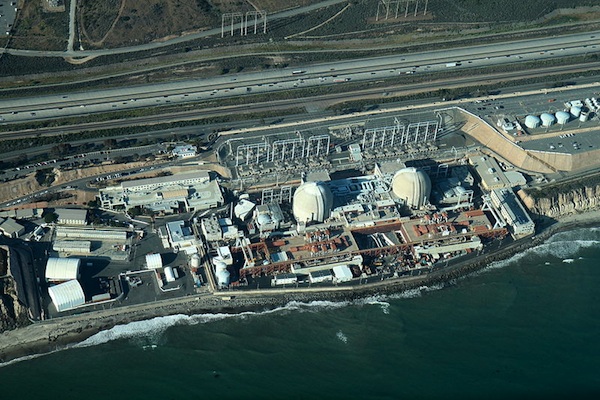
June 7 marks the first anniversary of Southern California Edison’s decision to permanently close the troubled San Onofre nuclear plant near San Clemente. Gene Stone of Residents Organized for a Safe Environment (ROSE) summed it up this way: “We are safer – but we are not yet safe.”
There are two crucial matters: the quality of storage technology on-site at San Onofre, and the prospects for long-term storage at a remote site.
Enter Senator Barbara Boxer and colleagues Sanders and Markey. On May 16 they introduced Senate bills S. 2324, 2325 and 2326, which would:
• Require the NRC to cease its current practice of issuing exemptions to emergency response and security requirements for spent fuel at closed nuclear reactors, unless all fuel storage at the site is in dry casks.
• Ensure that host states and communities have a meaningful role in shaping decommissioning plans for retired nuclear plants.
• Require for the first time that the NRC to explicitly and publicly approve or reject each proposed decommissioning plan.
• Ensure operator compliance with the NRC requirement that spent nuclear fuel be removed from pools and placed into dry cask storage within 7 years after the decommissioning plan is submitted to the NRC.
• Provide funding to help reactor licensees implement plans for decommissioning nuclear plants.
• Expand the emergency planning zone for non-compliant reactor operators to 50 miles.
The background
But back to Stone’s comments. The accuracy was confirmed at a May 6 workshop on managing nuclear fuel waste. Tom Palmisano, senior nuclear officer for Edison, reported that cooling pools at San Onofre currently hold 2668 spent fuel assemblies including 1115 “high burn-up,” a fuel type that is hotter both thermally and radioactively than conventional fuel.
Spent fuel from Unit 1 is already in dry casks holding 24 assemblies each. Removal of Unit 2 and Unit 3 fuel from pools will require 100 more 32-unit casks. This will triple the footprint of the concrete storage structure, from today’s 200 x 400 feet to an ultimate 400 x 600 feet.
Experts are unanimous that fuel pool hazards are far greater than dry cask storage and the intent is to complete transfer in 5 to 7 years. At that point the focus shifts to long-term safety of casks.
A lively debate at the May 6 workshop pitted Marvin Resnikoff of Radioactive Waste Management Associates against Michael McMahon from cask manufacturer AREVA and Drew Barto, lead on spent fuel storage and transportation for the U.S. Nuclear Regulatory Commission (NRC).
Resnikoff reviewed the performance hazards and risks in cask safety for long-term on-site storage and off-site transport. McMahon and Barto countered with advances in design technology that they say provide a robust and secure storage system even for high burn-up fuel. Through this exchange of sharply differing views, the workshop added value by throwing the spotlight on key technical issues in specific ways that can be debated to a point of resolution. Nuclear safety advocates will be watching the outcome closely.
The other major contribution of the workshop was to confirm a striking degree of unanimity regarding the need to revitalize the process for locating and developing sites for long-term remote storage. Gains in on-site safety promised by technology advances did not diminish the consensus that spent fuel waste should be removed from San Onofre at the earlier possible opportunity.
In part this reflects the unusually exposed nature of the San Onofre site. But sentiment runs deeper. Per Peterson, a member of the NRC’s Blue Ribbon Commission, expressed a feeling little short of dismay at the national failure to identify and develop remote storage. Edison said it is committed to this outcome as the fully satisfactory solution. Members of the expert panel as well as the Citizens Engagement Panel (CEP) that hosted the event made it clear that indefinite on-site storage remains unacceptable.
San Onofre as a test case
Message to the NRC: San Onofre may be the test case where all parties are urging a better way than the grotesque and inappropriate land-use outcome of constructing a nuclear waste mausoleum at San Onofre or at any other closed nuclear plant.
Dr. David Victor of UC San Diego chairs the CEP, which organized the workshop. He summed up the discussion this way: “We have an obligation to make the long-term storage of fuel as safe as possible and practical. We need a strategy for federal action on consolidated storage and ultimate repositories. Toward that end, we should articulate what we as a community need—and carry through with the Governor and Congress to assure they give priority to what is most important.”
The Boxer-Sanders-Markey bills are classic legislative oversight. They close safety-related loopholes and provide a more accountable and participatory process for affected area residents.
These sensible steps do not in themselves deal with on-site storage design technology or remote site development. But they are in the spirit of comprehensive nuclear waste management, which remains one of America’s largest environmental challenges.
Glenn Pascall is chair of the Chapter's San Onofre Task Force.